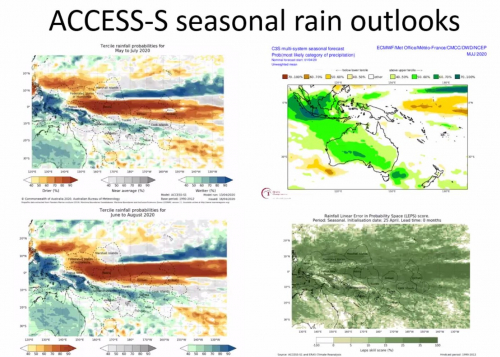
New climate products to help improve weather and climate forecasting through the Australian Community Climate Earth System Simulators-Seasonal (ACCESS-S) model are now available to Pacific Met Services.
Across the globe climate scientists rely on sophisticated models to predict the weather and climate on a weekly, monthly and seasonal basis. Models are either dynamical which uses physics of the oceans, atmosphere, land and ice to predict or statistical uses past data such as rainfall and temperature and the current El Niño-Southern Oscillation state to predict future climate.
Through the Climate and Oceans Support Programme in the Pacific (COSPPac) funded by the Australian government’s Department of Foreign Affairs and Trade, the ACCESS-S model brings enhanced resolutions, skill and capabilities to forecast with more regional details.
“Change is inevitable and most Pacific islanders are embracing change as we build our resilience, SPREP commends the Australia Bureau of Meteorology COSPPac team for leading in the implementation of ACCESS-S in the pacific to enhance weather and climate forecasting to further support our resilience building efforts,” said Ms Tagaloa Cooper-Halo, the Director of Climate Change Resilience of the Secretariat of the Pacific Regional Environment Programme (SPREP).
SPREP is an implementing partner with the Pacific Community and Geoscience Australia, of COSPPac.
“However, with the increase in number of climate extremes and hazards impacting the livelihoods, development and safety of Pacific peoples, the need to predict the future weather and climate is now needed more than ever. Models such as ACCESS-S helps us with this,” said Ms Cooper-Halo.
ACCESS-S replaces the Predictive Ocean Atmosphere Model for Australia (POAMA) model which has been phased out. ACCESS-S was first used in Australia in 2018 and was developed by the Australia Bureau of Meteorology in partnership with the UK Met Office.
Since ACCESS-S model is new to the Pacific, the Australia Bureau COSPPac team are taking all necessary measures to ensure ACCESS-S is accessible, understood and utilised by the Pacific National Met Services to predict the season ahead. This information will be translated from data into information products for decision making at all levels and across all sectors.

“The aim is to provide Pacific National Met Services with improve predictability and skill using ACCESS-S. It will also predict early development of El Niño Southern Oscillation (ENSO) which is a major driver of year to year climate and ocean variability in the Pacific,” said Mr Simon McGree, the COSPPac Australia Bureau Climatologist.
“This will lead to early detection of drought or periods of enhanced rainfall in the months ahead, which subsequently translate to defining appropriate actions to be taken by sectors and government agencies that might likely be impacted.”
April, is the first time ACCESS-S information products and maps have been shared with the Pacific Met Services with the support of SPC and SPREP.
“We are excited by this,” said Ms Celine Becker the COSPPac Manager.
“Australia Bureau have also recently hosted Fiji, PNG and Solomon Islands Climate Officers for ACCESS-S hands-on training and will continue training for the remaining Pacific countries once the COVID-19 travel restrictions are lifted. I also take this opportunity to thank our implementing partners SPREP, SPC and the Geoscience Australia for supporting us in the delivery of this activity.”
Phase 2 of the COSPPac Project is implemented across 14 Pacific islands. Funded by the Government of Australia Department of Foreign Affairs since 2018 to 2022. Implementing partners are Australia Bureau of Meteorology, Secretariat of the Pacific Regional Environment Programme, Pacific Community and Geoscience Australia. – COSPPac/SPREP
For more information on ACCESS-S please contact Simon McGree at [email protected] or SPREP COSPPac on [email protected].